<Back to Index>
- Conductor Carlo Maria Giulini, 1914
- Conductor, Composer and Double - Bassist Serge Koussevitzky, 1874
PAGE SPONSOR
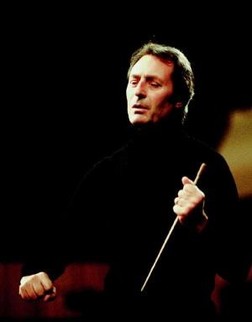
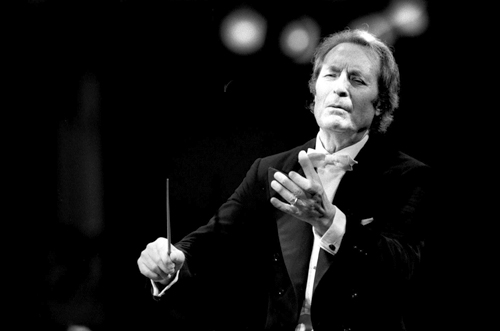
Carlo Maria Giulini (May 9, 1914 – June 14, 2005) was an Italian conductor.
Giulini was born in Barletta, Italy, to a father born in Lombardy and a mother born in Naples; but he was raised in Bolzano, which at the time of his birth was part of Austria (it was given to Italy in the Treaty of London (1915)). Therefore, most of the neighbors spoke a dialect of German, and the local music he heard tended to be Austrian / Tyrolean. He recalled being transfixed by the town band.
Giulini was given a violin for Christmas in 1919, when he was five, and progressed rapidly with local instructors, notably a Bohemian violinist (and local pharmacist) whom he called "Brahms." In 1928, the distinguished Italian violinist / composer Remy Principe (1889 – 1977) gave a recital in Bolzano, and auditioned Giulini; he invited Giulini to study with him at Italy's foremost conservatory, the Accademia Nazionale di Santa Cecilia in Rome. Giulini undertook his studies there two years later, at the age of 16. He studied viola with Principe, composition with Alessandro Bustini (1876 – 1970), and conducting with Bernardino Molinari.
At the age of 18, in order to supplement his family's income (which had been depleted by the Great Depression), he auditioned for the viola section of the Accademia Nazionale di Santa Cecilia's orchestra, at the time Italy's foremost orchestra. He recalled crying for joy when informed that he had won the audition and would be the orchestra's last - desk violist. Among the guest conductors he played under were Bruno Walter, Wilhelm Furtwängler, Richard Strauss, Victor de Sabata, Fritz Reiner, Pierre Monteux, Igor Stravinsky, and Otto Klemperer. His first public performance was the First Symphony of Brahms under Walter. Giulini told interviewers that he detested the dictatorial, often demeaning manner of Molinari, the orchestra's music director, but loved the gentle manner of Walter, who he said had a gift for making every musician feel important.
In 1940, Giulini won a conducting competition, whose prize was the chance to conduct the St. Cecilia orchestra, but before the concert, Giulini was drafted into the Italian army, made a second lieutenant, and sent to the front in Croatia. However, because of his commitment to pacifism and intense opposition to fascism and to Benito Mussolini, he did not fire his gun at human targets. In 1942, on a 30 day break in Rome, he married Marcella de Girolami (1926 – 1995), his girlfriend since 1938; they remained together until her death 53 years later. In September 1943, the Armistice between Italy and Allied armed forces was signed, but the Nazi occupation refused to abandon Rome, and Giulini's Italian commander ordered his troops to fight with the Nazis. Giulini chose instead to go into hiding, living for nine months in a tunnel underneath a home owned by his wife's uncle, along with two friends and a Jewish family which was avoiding Nazi arrest and deportation. Posters around Rome with his face and name instructed that he be shot on sight
After the Allies liberated Rome on June 4, 1944, Giulini - who was among the few conductors not tainted by associations with Fascism - was chosen to lead the Accademia's first post - Fascist concert, held on July 16, 1944. On the program was the Brahms Symphony No. 4, which he had studied while in hiding. It became the work he conducted most frequently over the course of his career, with a total of 180 performances.
Giulini began working with the Chamber Orchestra of Rome in 1944, and was made its music director in 1946. He worked with Milan Radio from 1946 to 1954, and also with the RAI's Rome orchestra. He conducted a staged opera for the first time in 1950 in Bergamo - La traviata, with Maria Callas and Renata Tebaldi alternating in the role of Violetta. He also revived several obscure operas, including works by Alessandro Scarlatti. His work in Bergamo came to the attention of Arturo Toscanini, when the latter heard his radio broadcast of Debussy's La mer (not Haydn's Il mondo della luna as has often been reported). Toscanini asked to meet the young conductor, and the two men formed a deep bond. Toscanini recommended Giulini for the musical directorship at La Scala; Giulini had also won the attention and support of Victor de Sabata, the principal conductor of La Scala. Sabata suffered a heart attack in 1953 and left the position, which went to Giulini. Though highly admired, he resigned after members of the audience jeered Maria Callas during a run of operas from February, 16 to April 27, 1956.
In 1955 he had made his American debut with the Chicago Symphony Orchestra, leading to a 23 year association with the orchestra; he was its Principal Guest Conductor from 1969 to 1972, although he continued to appear with them regularly until March 18, 1978. In 1956, he began his association with the Philharmonia Orchestra of London and the Royal Opera House, Covent Garden
In 1958, Giulini conducted a highly acclaimed production of Verdi's Don Carlos at the Royal Opera House, Covent Garden. During the 1960s, he was in great demand as a guest conductor of leading orchestras around the world, and made numerous well received recordings with the Philharmonia Orchestra of London and several others.
After 1968 Giulini abandoned opera, not wanting to compromise his artistic vision, and concentrated on orchestral works. In addition to his role in Chicago, he was music director of the Vienna Symphony from 1973 to 1976. From 1978 to 1984, he served as principal conductor and Music Director of the Los Angeles Philharmonic, launching his tenure there with performances of Beethoven's 9th Symphony. In 1982 he returned once more to opera, conducting a widely acclaimed production of Verdi's Falstaff with the Los Angeles Philharmonic.
Giulini's most notable opera recordings include the 1959 Philharmonia Orchestra and Chorus versions of Mozart's operas The Marriage of Figaro and Don Giovanni for EMI, as well as his live 1955 recording of Verdi's La traviata with Maria Callas. He also made recordings of Verdi's Requiem and the Four Sacred Pieces, which were highly praised. Admired orchestral records include Debussy's La mer and Nocturnes, Dvořák's 9th Symphony and Tchaikovsky's 6th Symphony with the Philharmonia Orchestra, Mussorgsky's Pictures at an Exhibition, Brahms's 4th Symphony and Mahler's 1st and 9th symphonies with the Chicago Symphony Orchestra, Beethoven's 3rd and 5th Symphonies, and Schumann's 3rd Symphony with the Los Angeles Philharmonic Orchestra, Mahler's Das Lied von der Erde with the Berlin Philharmonic Orchestra, Brahms's four Symphonies, Bruckner's 7th, 8th and 9th symphonies with the Vienna Philharmonic, and Dvořák's 7th and 9th Symphonies with the Royal Concertgebouw Orchestra of Amsterdam. Most of these discs were recorded for the Deutsche Grammophon label. His live recording of Britten's War Requiem made in the Royal Albert Hall in 1969 which is available as a BBC Legends recording was a Gramophone Award winner.
He was principal conductor and music director of the Los Angeles Philharmonic Orchestra from 1978 to 1984.
Giulini and his wife, Marcella (d. 1995), had three children. He died in Brescia, Italy at age 91.
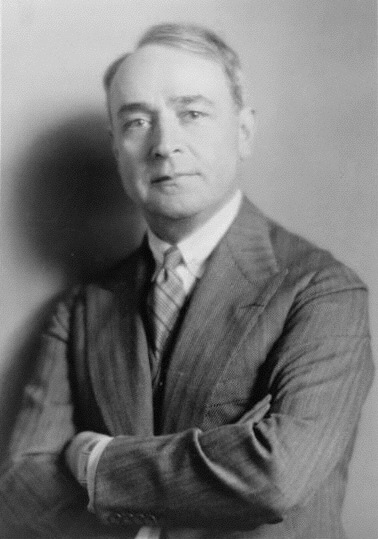
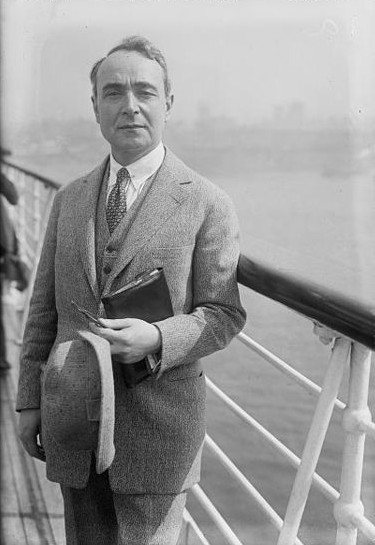
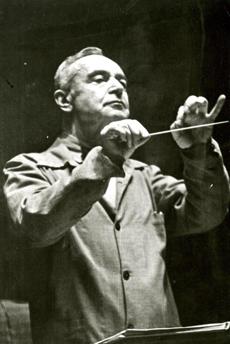
Serge Koussevitzky (Russian: Сергей Александрович Кусевицкий; Sergey Aleksandrovich Kusevitsky) (July 26 [O.S. July 14] 1874 – June 4, 1951), was a Russian born Jewish conductor, composer and double - bassist, known for his long tenure as music director of the Boston Symphony Orchestra from 1924 to 1949.
Koussevitzky was born into a poor Jewish family in Vyshny Volochyok, Tver Oblast, about 250 km northwest of Moscow, Russia. His parents were professional musicians who taught him violin, cello and piano. He also learned trumpet. He was baptized at the age of fourteen, since Jews were not allowed to live in Moscow and he had received a scholarship to the Musico - Dramatic Institute of the Moscow Philharmonic Society, where he studied double bass with Rambusek and music theory. He excelled at the bass, joining the Bolshoi Theater orchestra at the age of twenty, in 1894, and succeeded his teacher, Rambusek, as the principal bassist in 1901. That same year, according to some sources, he made his début (25 March) as a soloist in Moscow, although his biographer Moses Smith states he made his solo début earlier in 1896; he later won critical acclaim with his first recital in Berlin in 1903. In 1902 he married the dancer Nadezhda Galat. The same year, with Reinhold Glière's help, he wrote a popular concerto for the double bass, which he premiered in Moscow in 1905. In 1905, Koussevitzky divorced Galat and married Natalie Ushkov, the daughter of an extremely wealthy tea merchant. He soon resigned from the Bolshoi, and the couple moved to Berlin, where Serge studied conducting under Arthur Nikisch, using his new found wealth to pay off his teacher's gambling debts.
In Berlin he continued to give double bass recitals and, after two years practicing conducting in his own home with a student orchestra, he hired the Berlin Philharmonic and made his professional début as a conductor in 1908. The concert included Sergei Rachmaninoff's Piano Concerto No. 2, with the composer at the piano. The next year he and his wife returned to Russia, where he founded his own orchestra in Moscow and branched out into the publishing business, forming his own firm, Éditions Russes de Musique, and buying the catalogs of many of the greatest composers of the age. Among the composers published by Koussevitzky were Rachmaninoff, Alexander Scriabin, Sergei Prokofiev, Igor Stravinsky, and Nikolai Medtner. During the period 1909 to 1920 he continued to perform as soloist in Europe, and in Russia he and his orchestra toured towns along the Volga River by riverboat in 1910, 1912 and 1914. The programs included many new works. After the 1917 Russian Revolution, he accepted a position as conductor of the newly named State Philharmonic Orchestra of Petrograd (1917 – 1920). In 1920, he left the Soviet Union for Berlin and Paris. In Paris he organized the Concerts Koussevitzky (1921 – 1929), presenting new works by Prokofiev, Stravinsky, and Maurice Ravel. In 1924 he took a post in the United States, replacing Pierre Monteux as conductor of the Boston Symphony Orchestra. However, he continued to return to Paris in the summers to conduct his Concerts Koussevitzky until 1929. In 1941 he and his wife became United States citizens.
Koussevitzky's appointment as conductor of the Boston Symphony was the beginning of a golden era for the ensemble that would continue until 1949. Over that 25 year period, he built the ensemble's reputation into that of a leading American orchestra, and developed its summer concert and educational programs at Tanglewood. In the early 1940s, he discovered a young tenor named Alfred Cocozza (who would later be known as Mario Lanza), and provided him with a scholarship to attend Tanglewood. With the Boston Symphony he made numerous recordings, most of which were well regarded by critics. His students and protégés included Leonard Bernstein, Samuel Adler, and Sarah Caldwell. Bernstein once received a pair of cufflinks from Koussevitzky as a gift, and thereafter wore them at every concert he conducted.
Koussevitzky's second wife Natalie died in 1942, and he created the Koussevitzky Music Foundations in her honor. In late 1947, he married Olga Naumova, Natalie's niece. Naumova had lived with the couple and acted as their secretary for 18 years. Olga has been described as quiet, and soft spoken, and Leonard Bernstein and Aaron Copland counted her among their close friends.
Koussevitzky was a great champion of modern music, commissioning a number of works from prominent composers. During his time in Paris in the early 1920s he programmed much contemporary music, ensuring well prepared and good quality performances. Among the well received premieres were Honegger’s Pacific 231 and Roussel’s Suite in F.
For the Boston Symphony Orchestra's 50th anniversary, he commissioned Ravel's Piano Concerto in G, George Gershwin's Second Rhapsody, Prokofiev's Symphony No. 4 (which Prokofiev later revised), Paul Hindemith's Concert Music for Strings and Brass, and Stravinsky's Symphony of Psalms, as well as works by Albert Roussel and Howard Hanson.
In 1922, Koussevitzky commissioned Maurice Ravel's arrangement of Modest Mussorgsky's 1874 suite for piano, Pictures at an Exhibition, which was premiered on 19 October that year and quickly became the most famous and celebrated orchestration of the work. Koussevitzky held the rights to this version for many years.
Serge Koussevitzky died in Boston in 1951.
As an avid supporter of new music, Koussevitzky created the Koussevitzky Music Foundations in 1942. The basic aim of the foundations was to assist composers by commissioning new compositions and underwriting the cost of their performance. New works created with the foundations' support include: Benjamin Britten's opera Peter Grimes, Douglas Moore's opera The Ballad of Baby Doe, Béla Bartók's Concerto for Orchestra, Aaron Copland's Symphony No. 3, and Olivier Messiaen's Turangalîla - Symphonie.
Following Koussevitzky's 1951 death, his widow, Olga Koussevitzky, presented double bassist Gary Karr with his double bass, previously believed to have been fabricated in 1611 by brothers Antonio and Girolamo Amati. The instrument now bears the names of both Karr and Koussevitzky. The instrument was recently featured with bassist Scott Pingel and the San Francisco Academy Orchestra.
The Tanglewood Music Center awards the Koussevitzky Prize for outstanding student conductor. It has been awarded since 1954, but unlike many prizes, it is not awarded annually. Past winners have included Seiji Ozawa (1960) and Michael Tilson Thomas (1969).
Serge Koussevitzky recorded with the Boston Symphony exclusively for RCA Victor, except for a live recording made with Columbia (Roy Harris, "Symphony 1933") in Carnegie Hall, New York, during a concert, using portable equipment. One quite notable early RCA session in Boston's Symphony Hall in 1929 was devoted to an early recording of Ravel's Boléro, and his first sessions with the Boston orchestra of Beethoven's Pastoral Symphony and a suite from Stravinsky's Petrushka were recorded in Symphony Hall in 1927. His younger brother Fabian "Sevitzky" conducted the Indianapolis Symphony during this same period, making several recordings of his own for RCA Victor.
Some of Koussevitzky's later recordings, including performances of the second suite from Prokofiev's Romeo and Juliet (1945, Symphony Hall, Boston), first symphony (1947, Carnegie Hall, New York, a session that included Mendelssohn's "Italian" Symphony), and fifth symphony (1945, Symphony Hall, Boston), were reportedly mastered on Victor's revolutionary sound film optical recording process, first employed in this way with the San Francisco Symphony in March 1942.
His very last recordings, made in November 1950, on magnetic tape using RCA's proprietary RT - 21⁄4 - inch machines at 30 inches per second, were acclaimed performances of Sibelius's Second Symphony and Grieg's "The Last Spring". Both have been rereleased by RCA / BMG on CD in Taiwan. Some of Koussevitzky's performances at Tanglewood, including a very spirited Beethoven "Egmont Overture", were also filmed during the 1940s.
According to Music & Arts Programs of America, a number of the Boston Symphony's 78 rpm recordings with Koussevitzky were issued on the bargain RCA Camden label, originally released at US$1.98 for a 12 inch LP album when similar top - of - the - line Red Seals were selling for US$5.98, in the early 1950s as the "Centennial Symphony Orchestra". One of the later albums featured Prokofiev's Peter and the Wolf and Richard Strauss's Till Eulenspiegel's Merry Pranks; while the orchestra was again listed as the Centennial Symphony — and the conductor not identified, the narrator, actor Richard Hale, was. Koussevitzky ultimately rerecorded the piece in Tanglewood with Eleanor Roosevelt during the summer of 1950 on magnetic tape; issued on three 45s and a 10 inch LP, it has never been rereleased officially by RCA / BMG in spite of the popularity of the Camden disc with Hale. Hale was also the narrator for Arthur Fiedler's 1953 RCA recording of the same music with the Boston Pops. RCA often reissued historic recordings from the RCA Victor catalog on its Camden label with fictitious orchestral names to avoid having them in direct competition with newer recordings by the same artists on RCA Victor's upscale Red Seal label.